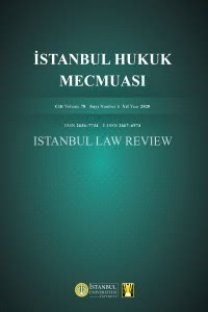Güzel Doğulmaz, Güzel Olunur!: Beauvoir’ın Aşkınlık, Irigaray’ın Taklit Düşüncesi Üzerinden Güzellik Sorunsalı
Arsel, kitabında Anayasa Mahkemesinin belirli bazı sorunlar hakkındaki genel tutumunu belirtmek ve bunlara ilişkin görüşlerini açıklamak amacını güdüyor. Yazarın ikinci amacı ne, Anayasa Mahkemesinin bazı kararlarından özetler vererek, yüksek mahkemenin belirli konular hakkındaki genel tutumunu aydınlığa kavuşturmak. Bu yüzden de kitap iki bölüm. Bölümlerden ilki ilk amaca ayrılmış ve »^Anayasa Mahkemesinin bazı eğilimleri konusunda» adını taşıyor. İkinci bölüm ise, <*Anayasa Mahkemesi kararlarından derlemeler» adını taşıyor ve yüksek mahkemenin belli başlı kararlarının bir fihristi niteliğinde. Kuşkusuz, kitabı incelerken üzerinde asıl durulması gereken bölüm birincisi. Yazar, hukuk ve siyaset alanımızda çok önemli bir göreve sahip kılınmış bulunan Anayasa Mahkemesinin belirli sorunlar karşısındaki genel tutumunu yansıtmakla ve değerlendirmekle kalmamış
Anahtar Kelimeler:
ANAYASA, MAHKEMESİNİN, EĞİLİMLERİ
One Is Not Born, But Rather Becomes, Beautiful!: Examination of Beauty Through Beauvoir's Transcendence and Irigaray's Mimicry Concepts
One Is Not Born, But Rather Becomes, Beautiful! is a stand of respect for Simone de Beauvoir's motto which says One Is Not Born, But Rather Becomes, A Woman!; it is also a critique of masculine domination based on the idea of identicalness between femininity and beauty. This paper combines beauty with the notion of femininity which is built by cultural and social norms and emphasizes the designs attributed to the nature of the woman. It also opens up a discussion about the methods of escape the beauty that is attributed to woman nature with Beauvoir's transcendence idea and Luce Irigaray's mimicry theory. Although Beauvoir's transcendence and Irigaray's imitation method may seem different at first glance, it is actually added end to end. Basically both thoughts centered on the equality of women and men, and both desired that the woman reaches male-specific transcendence. Transcendence, which is seen as the ultimate solution to be reached in Beauvoir, is not sufficient alone in Irigaray. As a matter of fact, Irigaray argues that the gender equality in question will be achieved through a transformation that will take place through language. The mimetic method is a must for linguistic transformation. This radical method suggested by Irigaray leads women to conquer the castle from inside by creating a reflection of the male dominant view. In addition to the suspence regarding the method's implemantation, transformation of beauty into a new masculine yoke for the transcendental woman leaves the methods discussed in terms of gender equality effectless. This research explores the methods of getting rid of this concept of beauty that imbues women through emphasizing that beauty attributed to the woman after home and housework pulled the woman into a control mechanism that she could not escape, it; It also questions whether Irigaray's mimicry strategy can offer a solution to this beauty problem.
Keywords:
Simone de Beauvoir, Luce Irigaray Beauty, Feminity, Beautiful Gender,
- ISSN: 2636-7734
- Yayın Aralığı: Yılda 4 Sayı
- Başlangıç: 1935
- Yayıncı: İstanbul Üniversitesi Yayınevi
Sayıdaki Diğer Makaleler
TECİL TALEBİNİN REDDİ HALİNDE GEREKÇE GÖSTERMEK ZORUNLU DEĞİLDİR
TÜRK CEZA KANUNU'NUN 513. MADDESİNİN 2. FIKRASI İLE 5917 SAYLI KANUNUN 7. MADDESİ ARASINDAKİ İLİŞKİ
A.B.D. KANUNLAR ÇATIŞMASI SİSTEMİNDE BOŞANMADA YETKİLİ MAHKEME VE MEKSİKA'DA ELDE EDİLEN BOŞANMALAR
UYUŞTURUCU MADDELERİN HUKUK VE KRİMİNOLOJİ İLE İLGİLİ BAZI YÖNLERİ
ESKİÇAĞ DÜNYASINDA KANUNLARIN VE HUKUKİ MUAMELELERİN YORUMU (GAUDEMET)
İCRA MEMURLARININ İŞ GÖRMEKTEN MEMNUİYETİ
ANAYASA İLE TEMEL HAK VE HÜRRİYETLER İLİŞKİSİ ÜSTÜNE İKİ SORUN VE BİR ÖRNEK OLAY
